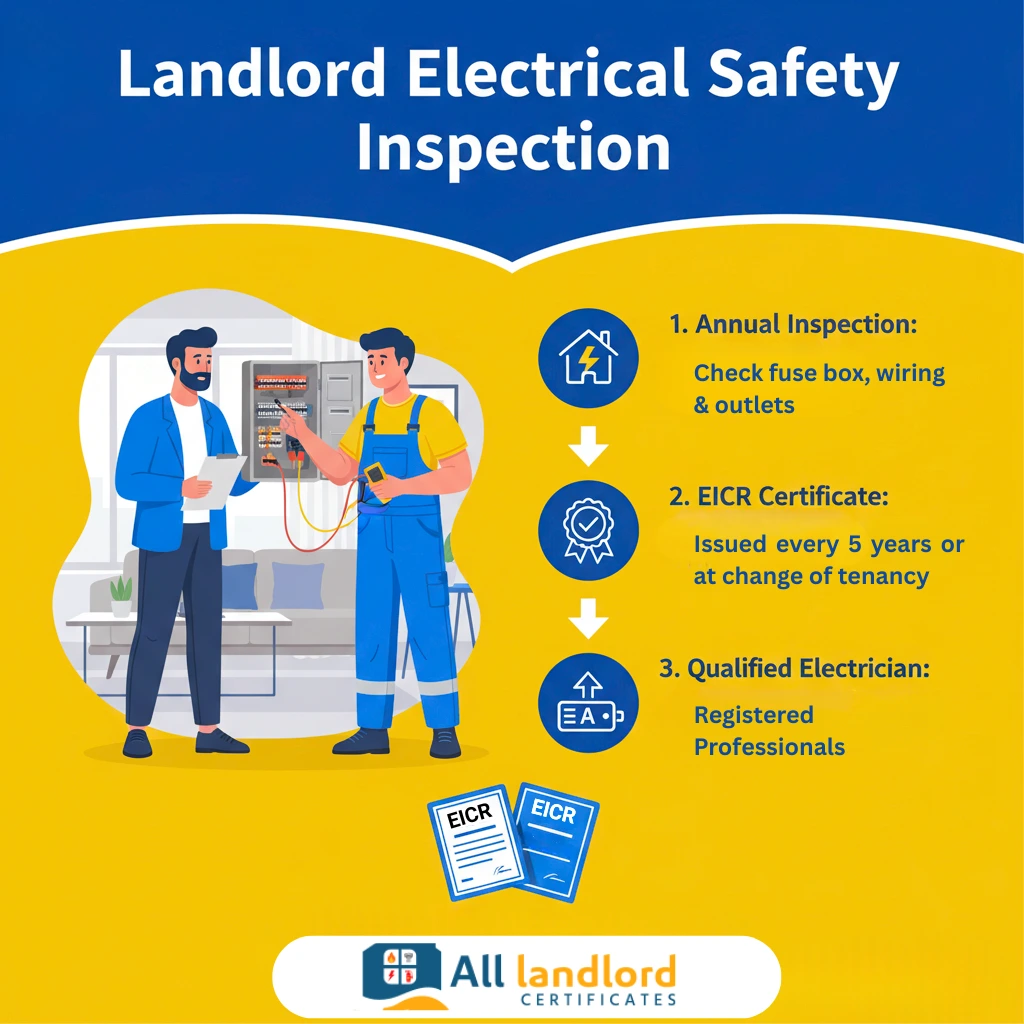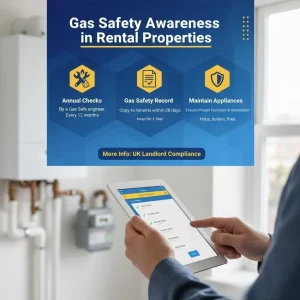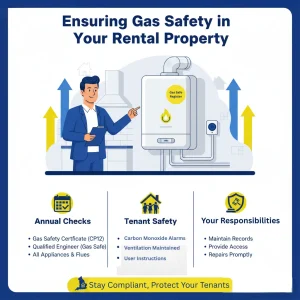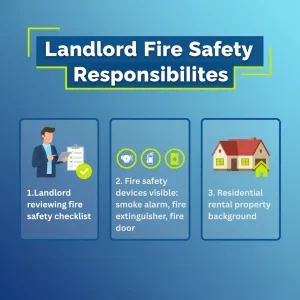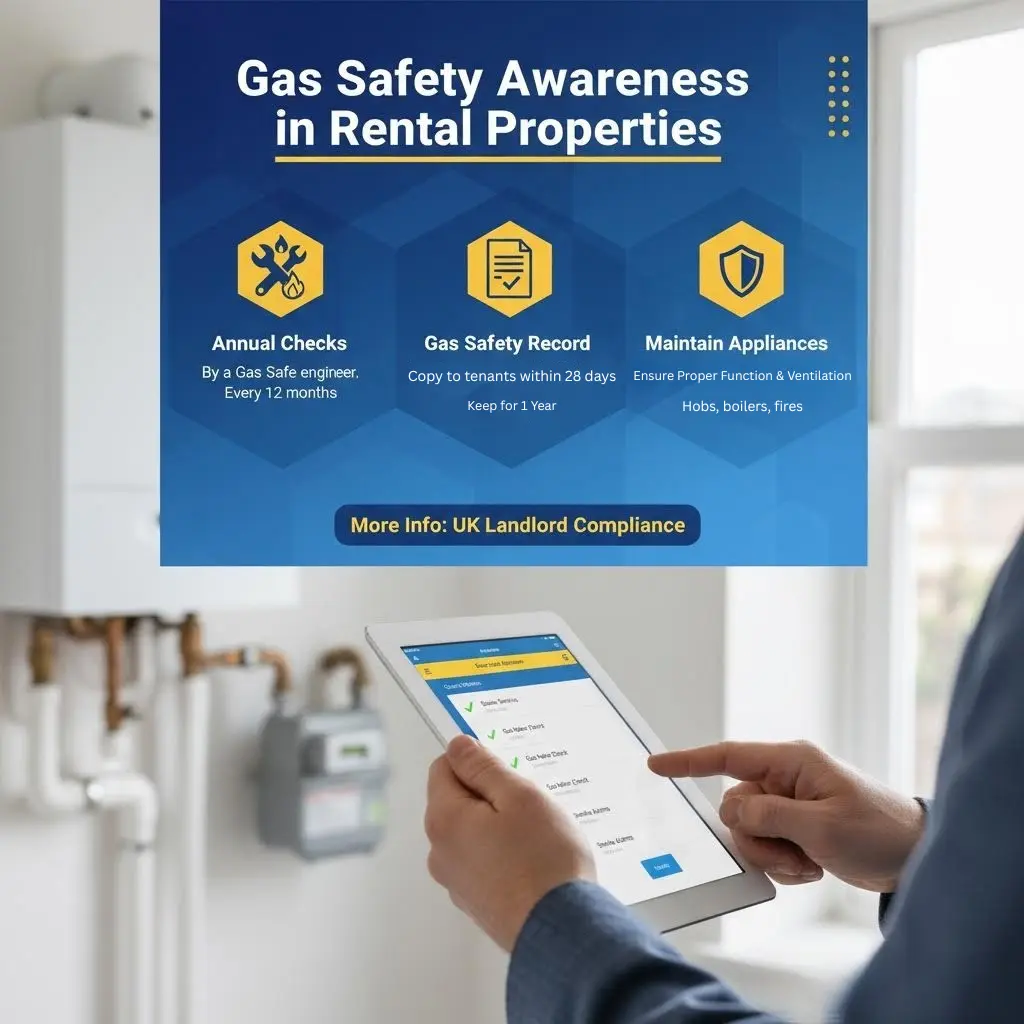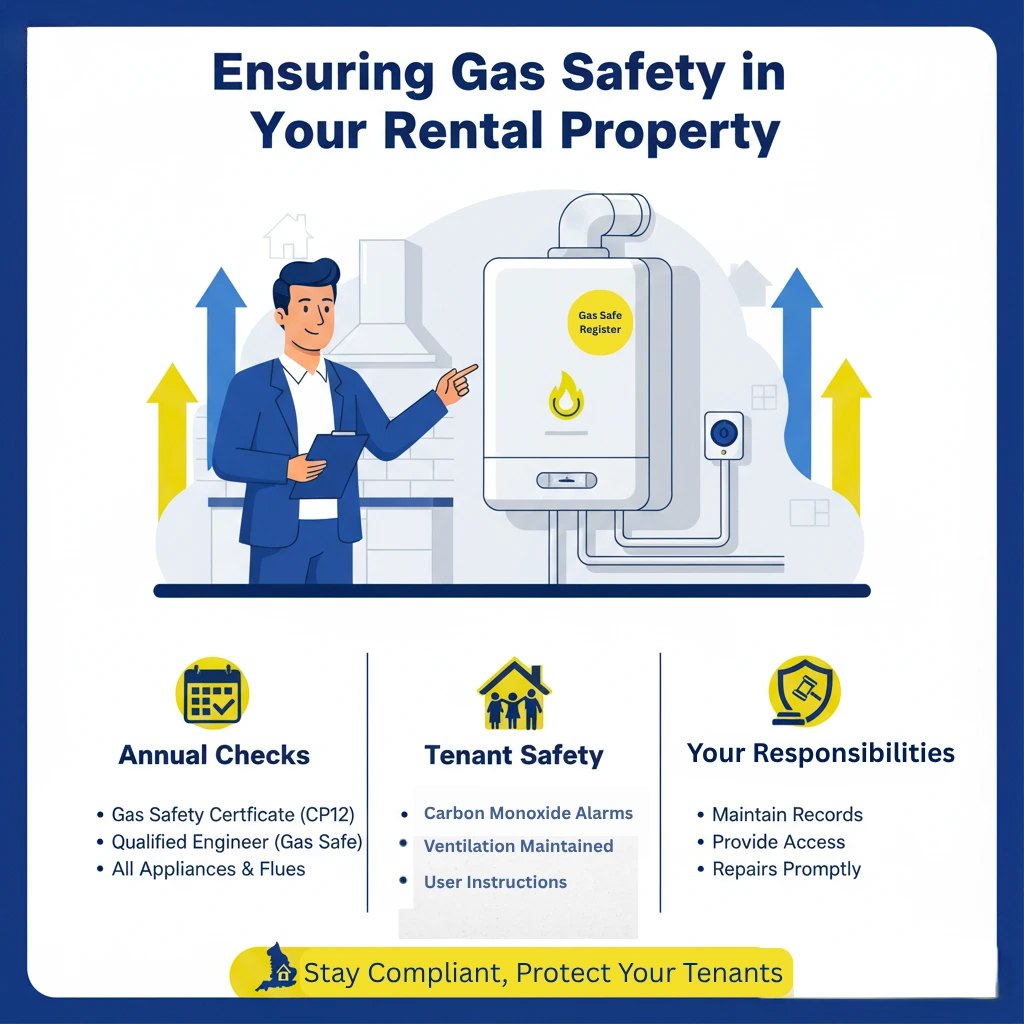If you rent out property in London, you must keep all electrical systems safe. The rules for landlords are strict and detailed. These rules are called the Electrical Safety Standards in the Private Rented Sector (England) Regulations 2020. They explain exactly what landlords need to do to make their properties safe. That’s why landlords need to take electrical safety seriously. Also, ensure every system and appliance is checked and maintained.
In this blog, you’ll get a clear guide for landlords. It explains the main electrical safety requirements, the compliance dates, and what happens if these regulations apply to your rental property and you fail to meet them.
What are the Electrical Safety Standards in the Private Rented Sector (England) Regulations 2020?
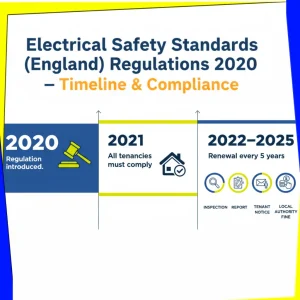
The electrical regulations for landlords apply to private rentals in England. Rentals must meet electrical safety standards. A qualified electrician checks wiring every 5 years under BS 7671 rules. The landlord gets an EICR showing faults and the next test date. Repairs must be done within 28 days or sooner if needed. Tenants get a copy within 28 days. New tenants can ask for it. The council can also request it. Landlords keep the report until the next test.
Key requirements explained for residential landlords
Landlords must arrange a full electrical inspection and test, known as an EICR. This report checks the condition of the electrical installations in their rental properties.
1. Right to Rent Checks:
Landlords must verify all adult tenants legal right to rent in the UK using valid passports, visas, or Home Office documents, or face fines or prosecution.
2. Tenancy Deposit Protection (TDP):
Landlords must protect deposits in a government-approved scheme within 30 days, provide prescribed information, and risk financial penalties or Section 21 restrictions if they fail.
3. Safety Certificates and Inspections:
• Gas Safety
Landlords must obtain an annual Gas Safety Certificate (CP12) from a Gas Safe engineer and provide a copy to tenants within 28 days.
• Electrical Safety
Landlords must conduct an Electrical Installation Condition Report (EICR) every 5 years and give tenants a copy within 28 days.
• Smoke and Carbon Monoxide Alarms
Landlords must install smoke alarms on every storey, carbon monoxide alarms in rooms with combustion appliances, and test alarms at tenancy start.
4. Energy Performance Certificate (EPC):
Landlords must provide a valid EPC rated E or above before letting, with fines for non-compliance up to £5,000.
5. Rent and Deposit Rules:
Landlords must follow tenancy agreements or legal notices for rent changes, keep deposits within legal limits, and limit holding deposits to one week’s rent.
6. Tenant Information and Documentation:
Landlords must provide the How to Rent guide, deposit protection details, Gas and electrical certificates, EPC, and contact information, or lose the right to serve a Section 21 notice.
7. Property Condition and Maintenance:
Landlords must keep the property safe, habitable, and well-maintained, addressing heating, plumbing, ventilation, sanitation, structural integrity, and hazards.
8. Licensing and Local Authority Requirements:
Landlords must obtain mandatory HMO licenses and any additional/selective licenses required by local councils or face fines and rent repayment orders.
9. Data Protection:
Landlords must register with the ICO if storing tenant data and comply with UK GDPR and Data Protection Act 2018.
10. Tax and Financial Duties:
Landlords must declare rental income, claim allowable expenses, and comply with Making Tax Digital (MTD) thresholds when applicable.
These electrical safety requirements say landlords must ensure electrical safety standards are met across all rental properties.
Timeline for implementation and compliance dates
The regulations apply to all private rented homes in England.![]() From July 2020 – New electrical safety rules applied to all new tenancies.
From July 2020 – New electrical safety rules applied to all new tenancies.![]() From April 2021 – All existing tenancies had to comply with electrical safety regulations.
From April 2021 – All existing tenancies had to comply with electrical safety regulations.
Now, every UK landlord must ensure that every electrical installation in their rental property is inspected and tested regularly. These routine electrical inspections help make sure the property meets safety standards. Also, all electrical appliances work safely.
Landlords ensure that electrical installations in their rental properties are maintained and safe for tenants at all times.
Penalties and consequences of non-compliance
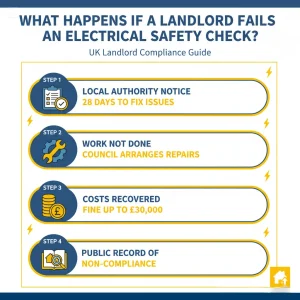
Failing to follow electrical safety requirements can lead to serious financial and legal issues. Here’s what can happen step by step:
Step 1: The local authority issues a notice if the property does not comply with electrical safety regulations.
Step 2: The landlord must carry out the required repairs within 28 days, or sooner if specified in the report.
Step 3: If the landlord ignores the notice, the local authority can arrange the electrical remedial work and recover the cost.
Step 4: The landlord may face a civil penalty of up to £30,000 for each breach.
Step 5: Repeated failure to meet electrical safety standards can lead to further enforcement action or being listed as a non-compliant landlord.
What are the specific electrical requirements for different types of rental properties?
As a Landlord in the UK, it is vital to ensure that the electrical systems in your rental are safe and reliable. Every property has its own risks, so it is important to carry out electrical checks regularly to prevent electrical faults. You must ensure that all electrical installations meet legal standards. Also, they have a current electrical installation certificate.
Electrical requirements for rented property
If you rent out a property, you must make sure all electrical systems are safe for tenants. For any rented home, regular electrical inspections are essential. Safe electrical systems prevent shocks, fires, and accidents. Checking all electrical installations can improve safety. It also helps prevent unexpected safety issues. Key points for rented properties:
![]() All wiring, sockets, switches, and fixed appliances must be safe and in good condition.
All wiring, sockets, switches, and fixed appliances must be safe and in good condition.![]() Landlords must arrange inspections every five years by a qualified electrician.
Landlords must arrange inspections every five years by a qualified electrician.![]() Tenants must get a copy of the electrical safety certificate before moving in.
Tenants must get a copy of the electrical safety certificate before moving in.![]() Any faults or problems must be fixed quickly.
Any faults or problems must be fixed quickly.![]() Electrical systems must meet UK safety standards (BS 7671).
Electrical systems must meet UK safety standards (BS 7671).
These rules form the basic electrical requirements for landlords to keep properties safe and legal.
Electrical regulations for HMOs (Houses in Multiple Occupation)
Houses in Multiple Occupation have more people living in one building, so electrical safety is even more important. UK law demands electrical checks and a proper electrical installation certificate for shared areas and individual units. Requirements for HMOs:
![]() Electrical systems must be inspected at least every five years.
Electrical systems must be inspected at least every five years.![]() Landlords must give tenants a copy of the Electrical Installation Condition Report (EICR).
Landlords must give tenants a copy of the Electrical Installation Condition Report (EICR).![]() Sockets and circuits must handle the needs of all occupants.
Sockets and circuits must handle the needs of all occupants.![]() Any faults must be repaired immediately.
Any faults must be repaired immediately.![]() Records of inspections and repairs must be kept and available for local authorities.
Records of inspections and repairs must be kept and available for local authorities.
HMOs require extra care because more tenants can increase the risk of electrical hazards. These rules are part of the electrical legislation for landlords.
Electrical testing regulations for commercial landlords
Commercial properties must protect employees, tenants, and visitors from electrical hazards. Key points for commercial properties:
![]() Electrical installations must have regular inspections and testing.
Electrical installations must have regular inspections and testing.![]() Landlords must keep an Electrical Installation Condition Report (EICR) as proof of safety.
Landlords must keep an Electrical Installation Condition Report (EICR) as proof of safety.![]() Faulty wiring or unsafe installations must be repaired immediately.
Faulty wiring or unsafe installations must be repaired immediately.![]() Portable appliances like kettles, computers, and heaters must be tested and maintained.
Portable appliances like kettles, computers, and heaters must be tested and maintained.![]() Following health and safety laws is essential to prevent accidents.
Following health and safety laws is essential to prevent accidents.
Maintaining safe electrical systems keeps everyone in the property safe. It also helps landlords follow the new electrical regulations for landlords.
How to obtain a valid Electrical Installation Condition Report (EICR)?
Getting a valid EICR starts with making sure your residential electrical system is checked properly. Landlords may also need to hire professionals to carry out a full electrical safety inspection. A thorough electrical safety check helps ensure that electrical appliances and electrical wiring in your property are safe. By doing this, you improve safety and can ensure safety for everyone living in the property.
Finding qualified electricians for inspections
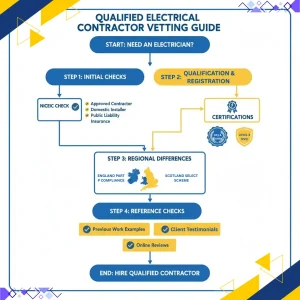
Finding the right professional matters because of the complexity of the electrical system. UK landlords look for experts who spot safety issues and make sure all electrical installations meet the right standards. Landlords already see the value in skilled electricians who encourage tenants to report electrical problems. This keeps the safety of your property strong and reliable. To locate trustworthy electricians:
![]() Check official registers: Use organizations like NICEIC, NAPIT, or ELECSA to find certified professionals.
Check official registers: Use organizations like NICEIC, NAPIT, or ELECSA to find certified professionals.![]() Verify credentials: Confirm their qualifications, insurance, and experience in conducting EICRs.
Verify credentials: Confirm their qualifications, insurance, and experience in conducting EICRs.![]() Read reviews and references: Look for feedback from previous clients to ensure reliability.
Read reviews and references: Look for feedback from previous clients to ensure reliability.![]() Request quotes: Compare multiple electricians to ensure competitive pricing and clarity on services provided.
Request quotes: Compare multiple electricians to ensure competitive pricing and clarity on services provided.
Understanding EICR classifications and remedial work
Once the inspection is complete, the report will show classifications of any electrical problems found. EICR reports classify findings to indicate the urgency of any issues:
![]() C1 – Danger Present: Immediate risk, remedial work must be done without delay.
C1 – Danger Present: Immediate risk, remedial work must be done without delay.![]() C2 – Potentially Dangerous: Urgent remedial work is required soon to prevent hazards.
C2 – Potentially Dangerous: Urgent remedial work is required soon to prevent hazards.![]() C3 – Improvement Recommended: No immediate danger, but improvements suggested for safety.
C3 – Improvement Recommended: No immediate danger, but improvements suggested for safety.![]() FI – Further Investigation Required: Additional checks needed before classification can be confirmed.
FI – Further Investigation Required: Additional checks needed before classification can be confirmed.![]() Remedial Work: Based on the classification, remedial actions range from replacing faulty wiring to upgrading the consumer unit or fixing unsafe sockets.
Remedial Work: Based on the classification, remedial actions range from replacing faulty wiring to upgrading the consumer unit or fixing unsafe sockets.
EICR validity period and renewal requirements
To improve safety, UK landlords must schedule follow-ups in time. Keeping track of dates and checks ensures that residential electrical systems remain safe. This process helps ensure safety and avoids any overlooked safety issues that could harm tenants.
![]() An EICR stays valid for five years in most homes. Some properties, like rental units or high-risk buildings, need checks more often, sometimes every one to two years.
An EICR stays valid for five years in most homes. Some properties, like rental units or high-risk buildings, need checks more often, sometimes every one to two years.![]() Schedule the next inspection before the current report runs out. If any changes happen in the electrical system or problems appear, get it checked sooner.
Schedule the next inspection before the current report runs out. If any changes happen in the electrical system or problems appear, get it checked sooner.![]() Keep the EICR in a safe place. It shows the property meets safety rules and may be needed for insurance or legal purposes.
Keep the EICR in a safe place. It shows the property meets safety rules and may be needed for insurance or legal purposes.
To get a valid EICR:
![]() Hire a qualified electrician or electrical contractor: Ensure they are registered with a recognized body (e.g., NICEIC, NAPIT, or ELECSA in the UK).
Hire a qualified electrician or electrical contractor: Ensure they are registered with a recognized body (e.g., NICEIC, NAPIT, or ELECSA in the UK).![]() Schedule an inspection: The electrician will inspect all wiring, circuits, consumer units, and safety devices.
Schedule an inspection: The electrician will inspect all wiring, circuits, consumer units, and safety devices.![]() Receive the report: After the inspection, the electrician issues a formal EICR detailing the condition of the installation, any defects, and recommendations.
Receive the report: After the inspection, the electrician issues a formal EICR detailing the condition of the installation, any defects, and recommendations.![]() Ensure report compliance: Verify that the report meets national standards (e.g., BS 7671 in the UK) and is signed by the qualified inspector.
Ensure report compliance: Verify that the report meets national standards (e.g., BS 7671 in the UK) and is signed by the qualified inspector.
Do landlords need to conduct PAT testing in rental properties?
PAT testing checks electrical appliances to make sure they are safe to use. For landlords, this protects both the property and the tenants. It is not a strict legal requirement, but landlords must make sure all supplied electrical items are safe and work properly. PAT testing gives a clear record that these checks happen.
Legal requirements for portable appliance testing
Landlords must ensure that all electrical items they provide in the property are safe. This includes items like fridges, kettles, toasters, and lamps. PAT testing is one way to show that appliances are safe.
Here is a simple guide:
![]() All electrical items supplied must be safe and in good condition.
All electrical items supplied must be safe and in good condition.![]() PAT testing shows that safety checks happen.
PAT testing shows that safety checks happen.![]() A qualified person should carry out the tests.
A qualified person should carry out the tests.![]() A visual check before tenants move in can spot clear problems.
A visual check before tenants move in can spot clear problems.
Laws that apply include:
![]() The Electrical Equipment (Safety) Regulations 1994 state that supplied electrical equipment must be safe.
The Electrical Equipment (Safety) Regulations 1994 state that supplied electrical equipment must be safe.![]() The Landlord and Tenant Act 1985 says the landlord must keep the property (and the items provided) in a safe state of repair.
The Landlord and Tenant Act 1985 says the landlord must keep the property (and the items provided) in a safe state of repair.![]() The Electrical Safety Standards in the Private Rented Sector (England) Regulations 2020 concern fixed electrical installations rather than plug‑in appliances.
The Electrical Safety Standards in the Private Rented Sector (England) Regulations 2020 concern fixed electrical installations rather than plug‑in appliances.![]() But these laws do not say “you must PAT test this appliance every year”. To protect everyone, landlords can’t ignore appliance safety.
But these laws do not say “you must PAT test this appliance every year”. To protect everyone, landlords can’t ignore appliance safety.
Frequency and documentation of PAT testing
The timing of testing depends on the use and condition of the appliances. For most rental properties, checking items every year keeps things safe. New appliances should be tested before tenants start using them. Because there is no strict legal requirement for how regular PAT tests must be conducted, the approach is based on risk and good practice.
Frequency
Because there is no universal legal interval in England/Wales, guidance suggests a risk‑based approach:
![]() Some sources suggest: high‑use items (e.g., kettle, toaster) annually, less frequently used items (e.g., lamps) every 2‑4 years.
Some sources suggest: high‑use items (e.g., kettle, toaster) annually, less frequently used items (e.g., lamps) every 2‑4 years.![]() For properties with greater risk (e.g., HMOs, shared accommodation), some local authority guidance recommends PAT every year.
For properties with greater risk (e.g., HMOs, shared accommodation), some local authority guidance recommends PAT every year.![]() Some accreditation standards recommend PAT at least every 5 years for appliances provided by the landlord.
Some accreditation standards recommend PAT at least every 5 years for appliances provided by the landlord.
Documentation
![]() If you carry out PAT testing, you should keep a record of: which appliances were tested, date, person/organization who carried it out, results, and any remedial action taken.
If you carry out PAT testing, you should keep a record of: which appliances were tested, date, person/organization who carried it out, results, and any remedial action taken.![]() Even if you do not conduct formal PAT testing, you should keep records of visual inspections (date, appliance, condition).
Even if you do not conduct formal PAT testing, you should keep records of visual inspections (date, appliance, condition).![]() If required by a licence, you may need to supply PAT test certificates or reports to the local authority.
If required by a licence, you may need to supply PAT test certificates or reports to the local authority.
Landlord responsibilities for tenant-owned appliances
Landlords do not need to test appliances that tenants bring, like TVs, microwaves, or kettles. Tenants are responsible for their own items. Landlords should still:
![]() Make sure sockets, wiring, and supplied appliances are safe
Make sure sockets, wiring, and supplied appliances are safe![]() Remind tenants to use their appliances safely
Remind tenants to use their appliances safely![]() Fix any electrical faults reported by tenants quickly
Fix any electrical faults reported by tenants quickly
Using PAT testing together with other electrical safety checks for landlords, such as inspecting fixed wiring, sockets, and hardwired appliances, keeps the property safe. These checks prevent accidents, protect tenants, and maintain the home in good condition.
How to manage remedial electrical works effectively?
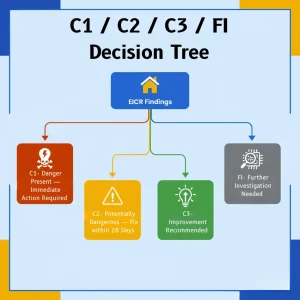
Managing electrical safety in rental properties is important for protecting tenants, the property, and yourself. A clear plan helps you keep everything organized and safe. This guide to electrical safety explains how to handle remedial electrical works, inspections, and ongoing maintenance.
Prioritizing electrical issues based on safety classifications
Start by understanding which issues need immediate attention. Electrical safety inspections show hazards that could cause injury or fire. Focus on high-risk problems first, and keep track of smaller issues so nothing is forgotten.
![]() Fix electrical faults that could harm tenants or damage property immediately.
Fix electrical faults that could harm tenants or damage property immediately.![]() Make a list of minor issues that require electrical work but do not pose an immediate risk.
Make a list of minor issues that require electrical work but do not pose an immediate risk.![]() Check your property regularly to spot new problems or changes.
Check your property regularly to spot new problems or changes.
Maintaining electrical safety in your rental protects tenants and reduces the risk of costly accidents.
Timeframes for completing remedial works
Set clear schedules for repairs, so tasks are completed on time and do not pile up.
C1 – Danger Present![]() Immediate risk of injury or fire.
Immediate risk of injury or fire.![]() Remedial work must be carried out immediately or as soon as reasonably practicable.
Remedial work must be carried out immediately or as soon as reasonably practicable.
Costs:![]() Fuse box replacement: £375–500
Fuse box replacement: £375–500![]() Urgent socket or wiring repairs: £100–300 per point
Urgent socket or wiring repairs: £100–300 per point![]() Complete rewiring (if required urgently): £1,900–6,500
Complete rewiring (if required urgently): £1,900–6,500
C2 – Potentially Dangerous
![]() Fault is unsafe and requires urgent action.
Fault is unsafe and requires urgent action.![]() Remedial work must be completed within 28 days of the report (or sooner if specified).
Remedial work must be completed within 28 days of the report (or sooner if specified).
Costs:![]() Minor wiring repairs or replacement: £100–300 per point
Minor wiring repairs or replacement: £100–300 per point![]() Partial rewiring (e.g., one or two rooms): £1,900–4,000
Partial rewiring (e.g., one or two rooms): £1,900–4,000![]() Fuse box upgrades: £375–500
Fuse box upgrades: £375–500
C3 – Improvement Recommended![]() Not unsafe, but improvement suggested.
Not unsafe, but improvement suggested.![]() No legal deadline for remedial action, but recommended to address.
No legal deadline for remedial action, but recommended to address.
Costs:![]() General rewiring improvements or circuit upgrades: £1,900–6,500.
General rewiring improvements or circuit upgrades: £1,900–6,500.![]() Replacement of outdated sockets, switches, or wiring accessories: £50 -150 per point.
Replacement of outdated sockets, switches, or wiring accessories: £50 -150 per point.
![]() Post-Remedial Certification
Post-Remedial Certification
After works are completed:
![]() Provide tenants with a copy of the updated electrical report or certificate within 28 days.
Provide tenants with a copy of the updated electrical report or certificate within 28 days.![]() Ensure certificates are issued by a qualified electrician, confirming the work has been completed in accordance with BS 7671 standards.
Ensure certificates are issued by a qualified electrician, confirming the work has been completed in accordance with BS 7671 standards.
![]() Practical Notes
Practical Notes![]() 28 days is the maximum timeframe for C2 issues unless a shorter period is specified.
28 days is the maximum timeframe for C2 issues unless a shorter period is specified.![]() For complex work, landlords must document reasonable steps taken if the 28-day limit cannot be met.
For complex work, landlords must document reasonable steps taken if the 28-day limit cannot be met.
Documentation and proof of completed remedial work
Keep detailed records of all electrical work. This proves work is done correctly and protects you if questions arise.
![]() Take photos of completed repairs and installations.
Take photos of completed repairs and installations.![]() Write notes about the work, tools used, and any special instructions.
Write notes about the work, tools used, and any special instructions.![]() Keep approvals or signatures from electricians if required.
Keep approvals or signatures from electricians if required.![]() Store records safely so you can access them during inspections or future maintenance.
Store records safely so you can access them during inspections or future maintenance.
Good documentation also shows tenants and inspectors that your property is maintained electrical responsibly.
What documentation must landlords provide to tenants regarding electrical safety?

Landlords give tenants important papers that show the electricity in the home is safe. This includes a report that checks all the wiring and electrical systems. They also share safety certificates for any appliances in the house. A qualified electrician does all the checks, and tenants can see the records anytime they want. This keeps the home safe and gives everyone peace of mind.
Required certificates and reports for new and existing tenants
When the inspection done, the landlord gets a report called an EICR. For inspections, landlords also choose companies like All Landlord Certificates to make the process simple and reliable. The report shows the results, confirms if the installation is safe to keep using, and lists the date for the next inspection. That report must be supplied to:
![]() Existing tenants within 28 days of the inspection.
Existing tenants within 28 days of the inspection.![]() A new tenant before they occupy the property.
A new tenant before they occupy the property.![]() Any prospective tenant within 28 days of their written request. In addition, if the report shows remedial work or further investigation is required (codes C1, C2 or FI), the landlord must carry out the work within 28 days (or sooner if the report requires) and then supply confirmation that the work is done. Although the regulations focus on fixed installations (wiring, fuse box, sockets, etc.), it is good practice for landlords to test any electrical equipment they supply (appliances) and keep records.
Any prospective tenant within 28 days of their written request. In addition, if the report shows remedial work or further investigation is required (codes C1, C2 or FI), the landlord must carry out the work within 28 days (or sooner if the report requires) and then supply confirmation that the work is done. Although the regulations focus on fixed installations (wiring, fuse box, sockets, etc.), it is good practice for landlords to test any electrical equipment they supply (appliances) and keep records.
Timeframes for providing electrical safety information
The key timeframes for landlords are:
![]() For new tenancies (in England) from 1 July 2020 the inspection must take place (or the previous valid inspection must apply).
For new tenancies (in England) from 1 July 2020 the inspection must take place (or the previous valid inspection must apply).![]() For existing tenancies (in England) by 1 April 2021 at the latest, the inspection rules apply.
For existing tenancies (in England) by 1 April 2021 at the latest, the inspection rules apply.![]() After the inspection and testing is done, a copy of the report must go to the tenant within 28 days.
After the inspection and testing is done, a copy of the report must go to the tenant within 28 days.![]() If the local housing authority requests the report, the landlord must supply it within 7 days of the request.
If the local housing authority requests the report, the landlord must supply it within 7 days of the request.![]() If the report indicates remedial work is needed, that work must be completed within 28 days (or sooner if the report says). Then the landlord must provide written confirmation of completion to the tenant and the authority.
If the report indicates remedial work is needed, that work must be completed within 28 days (or sooner if the report says). Then the landlord must provide written confirmation of completion to the tenant and the authority.
Record-keeping best practices for landlords
Keeping good records makes life easier for landlords and keeps tenants safe. Here’s what works well:
![]() Keep a copy of every EICR until the next inspection, which can be up to five years.
Keep a copy of every EICR until the next inspection, which can be up to five years.![]() Store proof of any repairs or work done alongside the report.
Store proof of any repairs or work done alongside the report.![]() Note down any appliances you check, the results, and when the next check is due.
Note down any appliances you check, the results, and when the next check is due.![]() Pass the last inspection report to whoever does the next inspection.
Pass the last inspection report to whoever does the next inspection.
Having everything organized means you can quickly show that the property is safe and that you follow the rules.
How do electrical regulations differ across UK regions?
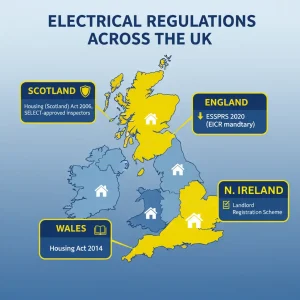
Electrical Safety for Landlords depends on following the rules in the area where the property is. Each part of the UK has its own rules for inspections, certificates, and safety checks. Knowing the differences keeps tenants safe and landlords protected.
Comparing regulations in England, Scotland, Wales, and Northern Ireland
Each UK region sets its own electrical rules for rental properties. Landlords need to know what applies to their area. Take a look at that table:
Region
Key Electrical Rules
Focus Areas for Landlords
Inspection Frequency
England
Regular inspections, electrical certificates
Keeping records, scheduling inspections
Safety requires certificates for all rented properties
Scotland
Periodic testing, detailed safety checks
Extra testing steps, ensuring compliance
Helps maintain high safety standards for tenants
Wales
Documentation, reporting to local authorities
Filing reports, maintaining logs
Local authorities may request proof of checks
Northern Ireland
Separate safety standards, reporting process
Following specific NI rules, timely reports
Electrical safety includes compliance with NI-specific rules
Region
Key Electrical Rules
Focus Areas for Landlords
Notes
England
Regular inspections, electrical certificates
Keeping records, scheduling inspections
Safety requires certificates for all rented properties
Scotland
Periodic testing, detailed safety checks
Extra testing steps, ensuring compliance
Helps maintain high safety standards for tenants
Wales
Document-
ation, reporting to local authorities
Filing reports, maintaining logs
Local authorities may request proof of checks
Northern Ireland
Separate safety standards, reporting process
Following specific NI rules, timely reports
Electrical safety includes compliance with NI-specific rules
Local authority requirements and variations
Local councils can add extra rules for electrical safety. Landlords need to follow both national and local requirements.
![]() Some councils ask for additional inspections.
Some councils ask for additional inspections.![]() Timelines for inspections may differ by area.
Timelines for inspections may differ by area.![]() Contacting the local council before renting avoids surprises.
Contacting the local council before renting avoids surprises.![]() Following these rules keeps electrical safety regulations for landlords strong and reliable.
Following these rules keeps electrical safety regulations for landlords strong and reliable.
Staying updated with changing electrical legislation
Electrical rules change over time. Landlords need to stay informed to keep properties safe.
![]() Check official government updates regularly.
Check official government updates regularly.![]() Sign up for newsletters from professional electricians.
Sign up for newsletters from professional electricians.![]() Keep records of inspections and certificates.
Keep records of inspections and certificates.![]() Staying aware of changes ensures electrical safety remains effective.
Staying aware of changes ensures electrical safety remains effective.
How do electrical regulations interact with other landlord safety obligations?
Keeping electrical safety in check is only one piece of the property safety puzzle. It works alongside gas checks, smoke alarms, and fire precautions. When landlords manage all these safety steps together, homes stay safe, tenants feel secure, and running properties becomes much easier.
Coordinating electrical, gas, and fire safety compliance
Keeping all safety checks in sync makes managing a property easier.
![]() Schedule electrical, gas, and fire inspections together when possible.
Schedule electrical, gas, and fire inspections together when possible.![]() Keep separate records for each type of safety check.
Keep separate records for each type of safety check.![]() Make sure tenants know when inspections happen.
Make sure tenants know when inspections happen.![]() Electrical safety never conflicts with gas or fire safety rules.
Electrical safety never conflicts with gas or fire safety rules.
Impact of electrical regulations on EPC ratings and efficiency
Electrical compliance can affect how energy-efficient a property is.
![]() Proper wiring and safe installations can improve energy use.
Proper wiring and safe installations can improve energy use.![]() Faulty electrical systems may lower efficiency ratings.
Faulty electrical systems may lower efficiency ratings.![]() Maintaining electrical safety supports better EPC scores and tenant comfort.
Maintaining electrical safety supports better EPC scores and tenant comfort.
Incorporating electrical safety into overall property management
Electrical safety should fit into the day-to-day running of a rental property.
![]() Include electrical checks in your regular maintenance schedule.
Include electrical checks in your regular maintenance schedule.![]() Train staff or contractors to spot safety issues early.
Train staff or contractors to spot safety issues early.![]() Keep all certificates and inspection reports organized.
Keep all certificates and inspection reports organized.![]() Treat electrical safety as a core part of property management.
Treat electrical safety as a core part of property management.
Case Study: Tower Hamlets Fire Highlights Critical Electrical Safety Failures for Landlords
In March 2025, landlords Sofina Begum and Aminur Rahman were fined nearly £100,000 after a fire in one of their Tower Hamlets flats. The flat housed up to 23 people, and the fire tragically caused a fatality. This case shows why electrical safety is crucial for landlords.
Key points:
![]() Fire started from an e-bike battery stored in the flat.
Fire started from an e-bike battery stored in the flat.![]() The property was overcrowded with up to 23 residents.
The property was overcrowded with up to 23 residents.![]() Landlords were fined nearly £100,000 for failing to ensure safety.
Landlords were fined nearly £100,000 for failing to ensure safety.![]() The incident highlights the importance of:
The incident highlights the importance of:
![]() Regular electrical inspections (EICR checks)
Regular electrical inspections (EICR checks)![]() Safe storage and use of electrical devices
Safe storage and use of electrical devices![]() Complying with fire and electrical safety regulations
Complying with fire and electrical safety regulations
![]() Ensuring safety can prevent injuries, fatalities, and heavy fines.
Ensuring safety can prevent injuries, fatalities, and heavy fines.
Final Thoughts
Time to finish up! After reading this, landlords can use the blog as a guide to review their properties and understand the key rules. It helps them make sure every property meets all electrical safety requirements. As a landlord, now you know what’s needed to keep your property safe.
Take the next step and book your Electrical Safety Certificate (EICR) with All Landlord Certificates today. We make electrical compliance simple, fast, and stress-free for every landlord.
